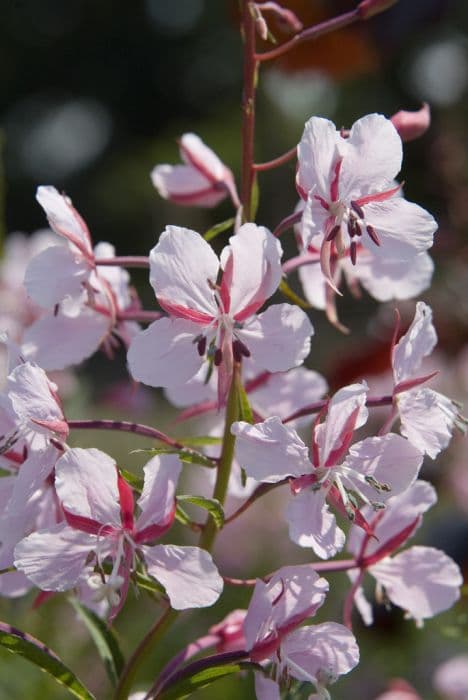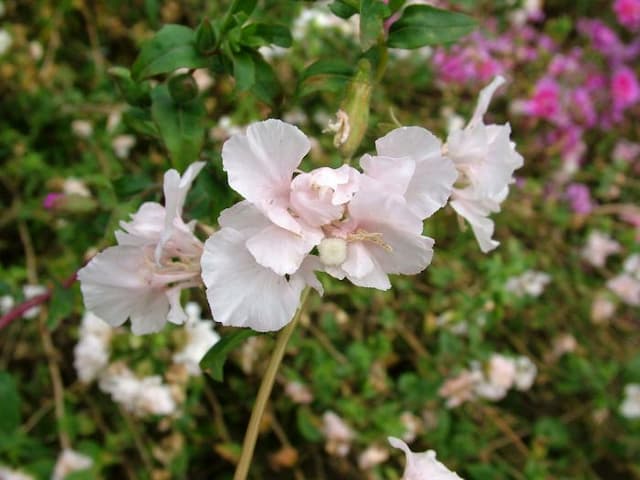Hardy fuchsia Fuchsia magellanica var. molinae

ABOUT
The hardy fuchsia, as it often called, is a charming, decidely elegant shrub known for its enchanting flowers and graceful growth habit. Its blossoms are a standout feature, with long, tubular shapes that dangle like pendant earrings from the branches. The flowers exhibit a delicate color palette, most commonly seen in soft shades of pink and purple. The petals are slender, with the outer ones gracefully curving back, while the inner petals often exhibit a paler hue, creating a beautiful contrast against the darker outer petals. This shrub boasts a profusion of these lovely flowers throughout the summer months, which are a magnet for hummingbirds and other pollinators. The foliage of the hardy fuchsia consists of small, lance-shaped leaves that line the thin, arching branches. The leaves present a subtle green hue with a soft, matte finish, and their modest size serves to frame and accentuate the vibrant display of the flowers. In combination, the array of finely textured leaves and stunning blooms creates a romantic and whimsical appearance that is both eye-catching and serene. This ornamental beauty is a favorite for adding a touch of color and delicate form to gardens and outdoor spaces.
About this plant
 Names
NamesFamily
Onagraceae
Synonyms
Hardy Fuchsia, Hummingbird Fuchsia, Lady's Eardrops
Common names
Fuchsia magellanica subsp. molinae, Fuchsia magellanica var. eburnea, Fuchsia magellanica 'Alba'
 Toxicity
ToxicityTo humans
The plant commonly known as Hardy Fuchsia is not considered highly toxic to humans. However, like many plants, if ingested in large quantities, it may still cause mild digestive upset. Symptoms could potentially include nausea, vomiting, or diarrhea. It is generally recommended to avoid eating ornamental plants due to their unknown effects and possible use of pesticides or other chemicals.
To pets
Hardy Fuchsia is also not considered highly toxic to pets, including dogs and cats. While it is uncommon for pets to experience severe reactions, ingestion may possibly lead to mild gastrointestinal upset, manifested as vomiting or diarrhea. As with humans, it is generally advisable to prevent pets from consuming plants not meant for their diet.
 Characteristics
CharacteristicsLife cycle
Perennials
Foliage type
Deciduous
Color of leaves
Green
Flower color
Pink
Height
4 feet [1.22 meters]
Spread
4 feet [1.22 meters]
Plant type
Shrub
Hardiness zones
6
Native area
Chile Argentina
Benefits
 General Benefits
General Benefits- Aesthetic Appeal: Adds a splash of delicate pink and purple hues to gardens, attracting visual interest.
- Attracts Pollinators: Provides an excellent nectar source for bees, butterflies, and hummingbirds promoting biodiversity.
- Versatility in Landscaping: Can be used in a variety of settings, such as in hanging baskets, borders, or as standalone shrubs.
- Easy to Propagate: Can be easily propagated through cuttings, allowing gardeners to expand their collection.
- Long Blooming Season: Offers flowers from late spring until early fall, providing a long season of color.
- Cold Hardy: Capable of surviving in cooler climates, thus extending its range of cultivation.
- Shade Tolerance: Can grow in partial shade, offering flexibility in garden design and location.
 Medical Properties
Medical PropertiesThis plant is not used for medical purposes.
 Air-purifying Qualities
Air-purifying QualitiesThis plant is not specifically known for air purifying qualities.
 Other Uses
Other Uses- Fuchsia magellanica var. molinae, commonly known as Hardy fuchsia, can be used in making natural dyes for textiles. The berries can produce a subtle pink or purple color when used in the dyeing process.
- The tart berries of the Hardy fuchsia are sometimes used in making jams and jellies, offering a unique flavor to culinary enthusiasts.
- With proper permissions, branches from the Hardy fuchsia can be used in floral arrangements and bouquets, providing a striking contrast with its drooping flowers.
- In some gardens, the plant can be trained to form hedges that offer privacy and a burst of color when it blooms.
- A landscape designer may include Hardy fuchsia as a natural backdrop for outdoor theaters or performance spaces due to its height and dense foliage.
- Having a nectar-rich flower, the plant acts as an attractor for beneficial pollinators like bees and hummingbirds, supporting local ecosystems.
- Leaves from the Hardy fuchsia can be used in compost piles as they decompose well and enrich the compost with nutrients.
- Artists may use the vibrant colors of the Hardy fuchsia plant as inspiration for paintings, textiles, or decorative motifs in crafts.
- Educational institutions might incorporate the Hardy fuchsia in botanical studies due to its adaptability and ease of propagation as a teaching tool.
- In shaded garden nooks, the plant can be used to create a tranquil and shaded retreat, ideal for reading or relaxation.
Interesting Facts
 Feng Shui
Feng ShuiThe plant_name is not used in Feng Shui practice.
 Zodiac Sign Compitability
Zodiac Sign CompitabilityThe plant_name is not used in astrology practice.
 Plant Symbolism
Plant Symbolism- Confiding Love: Fuchsia is often associated with confiding love. The intricate and somewhat pendant shape of the fuchsia blossoms can be reminiscent of a heart, symbolizing deep emotional connections and trust.
- Elegance and Good Taste: With its graceful drooping flowers and striking coloration, the fuchsia plant often symbolizes elegance, refinement, and good taste.
- Amiability: The fuchsia has a friendly and welcoming appearance, making it a symbol of amiability and warm hospitality.
- Overflowing Abundance: The fuchsia plant, especially when in full bloom, suggests abundance and overflowing plenty because of its numerous bell-shaped flowers.
 Water
WaterHardy Fuchsia should be watered deeply whenever the top inch of soil feels dry to the touch. In general, this might mean watering once a week, depending on your climate and the weather conditions. They prefer consistent moisture, so during particularly hot or dry periods, they may need watering twice a week. Provide about one to two gallons per plant for each watering to ensure the moisture reaches the root zone. Adjust the amount and frequency as needed based on rainfall and temperature changes, but avoid overwatering, which can lead to root rot.
 Light
LightThe Hardy Fuchsia thrives in a location with partial shade or filtered sunlight. They can tolerate morning sun but need protection from the intense, direct afternoon sunlight to prevent scorching of leaves. The ideal spot is one where they receive bright but indirect light; an east-facing or north-facing location is often suitable for these conditions.
 Temperature
TemperatureHardy Fuchsia plants perform best in temperatures ranging from 60°F to 75°F. They can tolerate a minimum temperature of around 40°F, but frost can damage them. The maximum temperature they can handle without stress is around 85°F. They prefer a cooler climate and might need protection from extreme heat during the summer months.
 Pruning
PruningPrune Hardy Fuchsia in late winter or early spring, before new growth begins, to maintain its shape and encourage bushier growth. Deadheading throughout the blooming season promotes more flowers. It is also important to cut back any dead or diseased branches to maintain plant health. Generally, a light pruning each year is sufficient, but if the plant has become overgrown, it can be cut back more severely at this time.
 Cleaning
CleaningAs needed
 Soil
SoilThe Hardy Fuchsia thrives in a well-draining soil mix composed of loam, peat, and sand, with a slightly acidic to neutral pH of 6 to 7. A good mix is 1 part loam, 1 part peat, and 1 part coarse sand. Mulching helps maintain moisture and protects the roots.
 Repotting
RepottingHardy Fuchsias should typically be repotted every two to three years to prevent root-bound conditions and to refresh the soil, ensuring healthy growth and vibrant blooms.
 Humidity & Misting
Humidity & MistingHardy Fuchsias prefer moderate to high humidity levels, aiming for about 60-70% relative humidity for optimal growth without flowers dropping and leaves wilting.
 Suitable locations
Suitable locationsIndoor
Place in bright, indirect light, and maintain high humidity.
Outdoor
Plant in dappled shade, shelter from strong winds.
Hardiness zone
6-9 USDA
 Life cycle
Life cycleFuchsia magellanica var. molinae, commonly known as "Lady's eardrops" or "Hardy fuchsia," begins its life cycle when the seeds germinate, typically in warm, moist soil conditions. The seedlings then develop into young plants with a characteristic bushy growth habit, comprising oval leaves and a woody structure as they mature. Over time, during the flowering season which generally peaks in the summer months, the plant produces its distinctive pendent flowers with a long tube and sepals that are usually pink to purple and corolla that can be a lighter pink to white. Following pollination, which is often assisted by hummingbirds and other pollinators, the flowers give way to small, dark purple fruits, technically berries, which contain seeds for the next generation. Lady's eardrops may experience a period of dormancy during colder months, especially in temperate climates, but is capable of rebounding in the subsequent growing season if the plant does not succumb to frost. With proper care and in suitable climates, Fuchsia magellanica var. molinae can be a long-lived perennial, adding color and vivacity to gardens for many years.
 Propogation
PropogationPropogation time
Spring-Early Summer
The Fuchsia magellanica var. molinae, commonly known as Hardy Fuchsia, is often propagated by softwood cuttings during the spring or early summer when the plant's growth is most vigorous. A popular method begins with choosing a healthy non-flowering shoot and cutting a 4 to 6-inch (approximately 10 to 15 cm) length just below a leaf node. The lower leaves are then removed, and the cutting may be dipped in rooting hormone to encourage root development. The prepared cutting is inserted into a pot filled with a well-draining potting mix, ensuring at least two nodes are buried. The pot is then placed in a warm, humid environment with indirect light. Ensuring the soil remains consistently moist but not waterlogged is crucial to successful root establishment, which can usually be expected within a few weeks.









